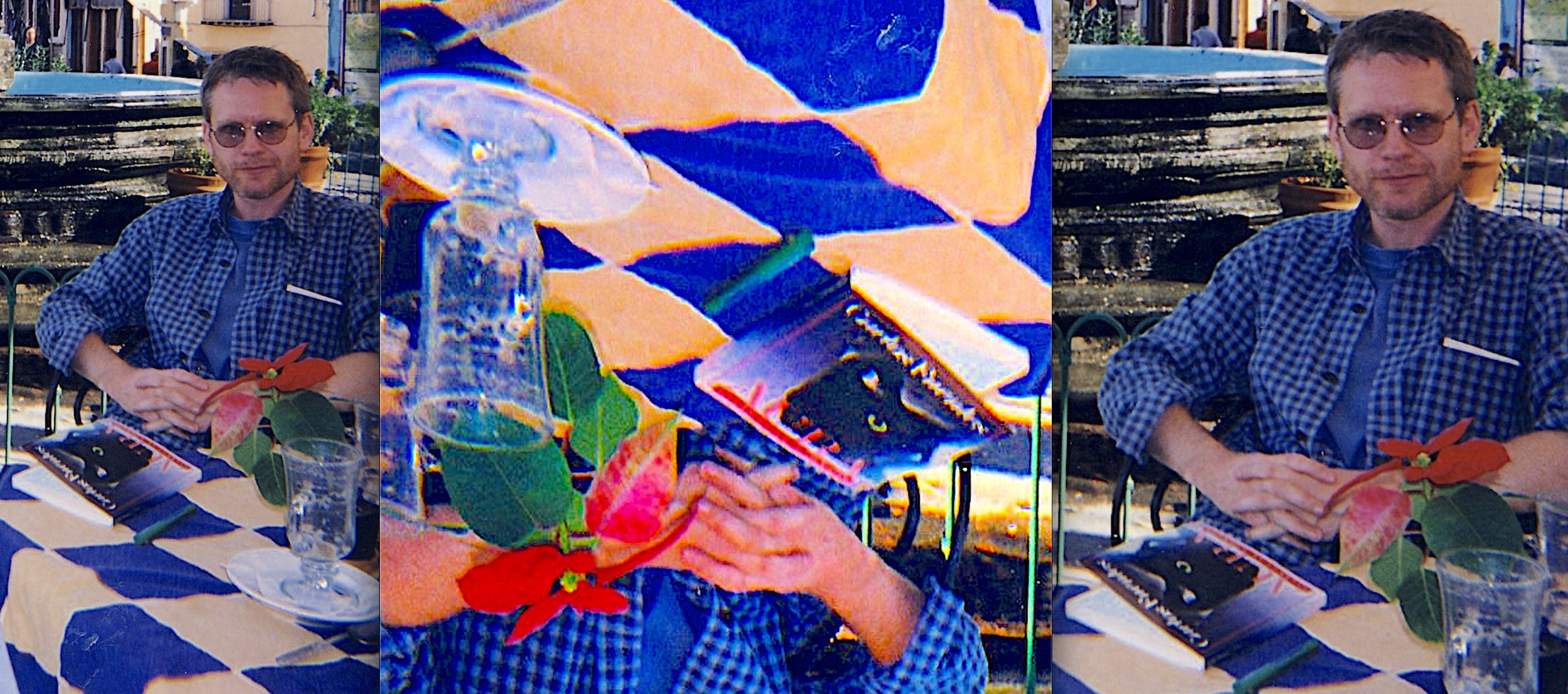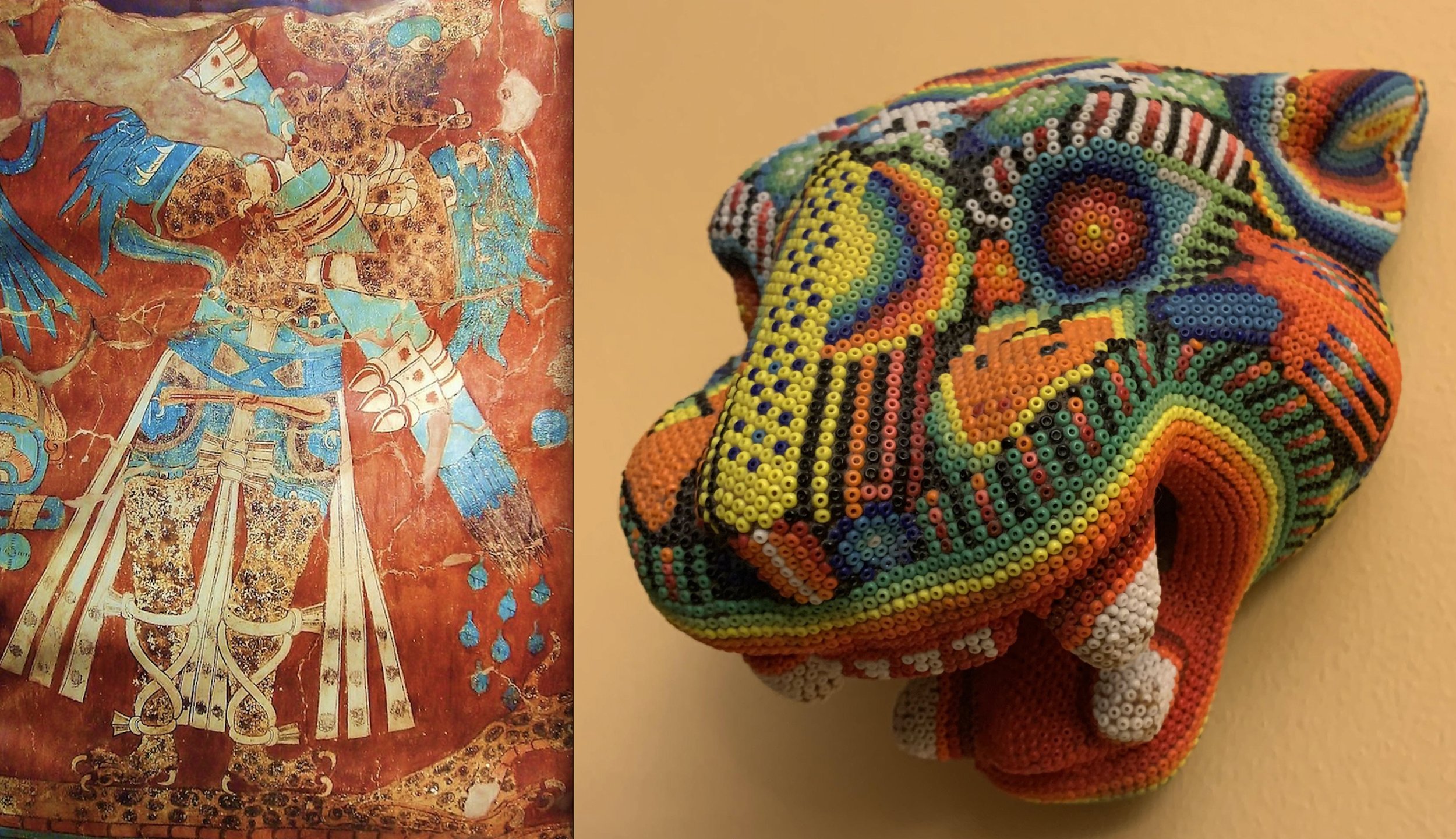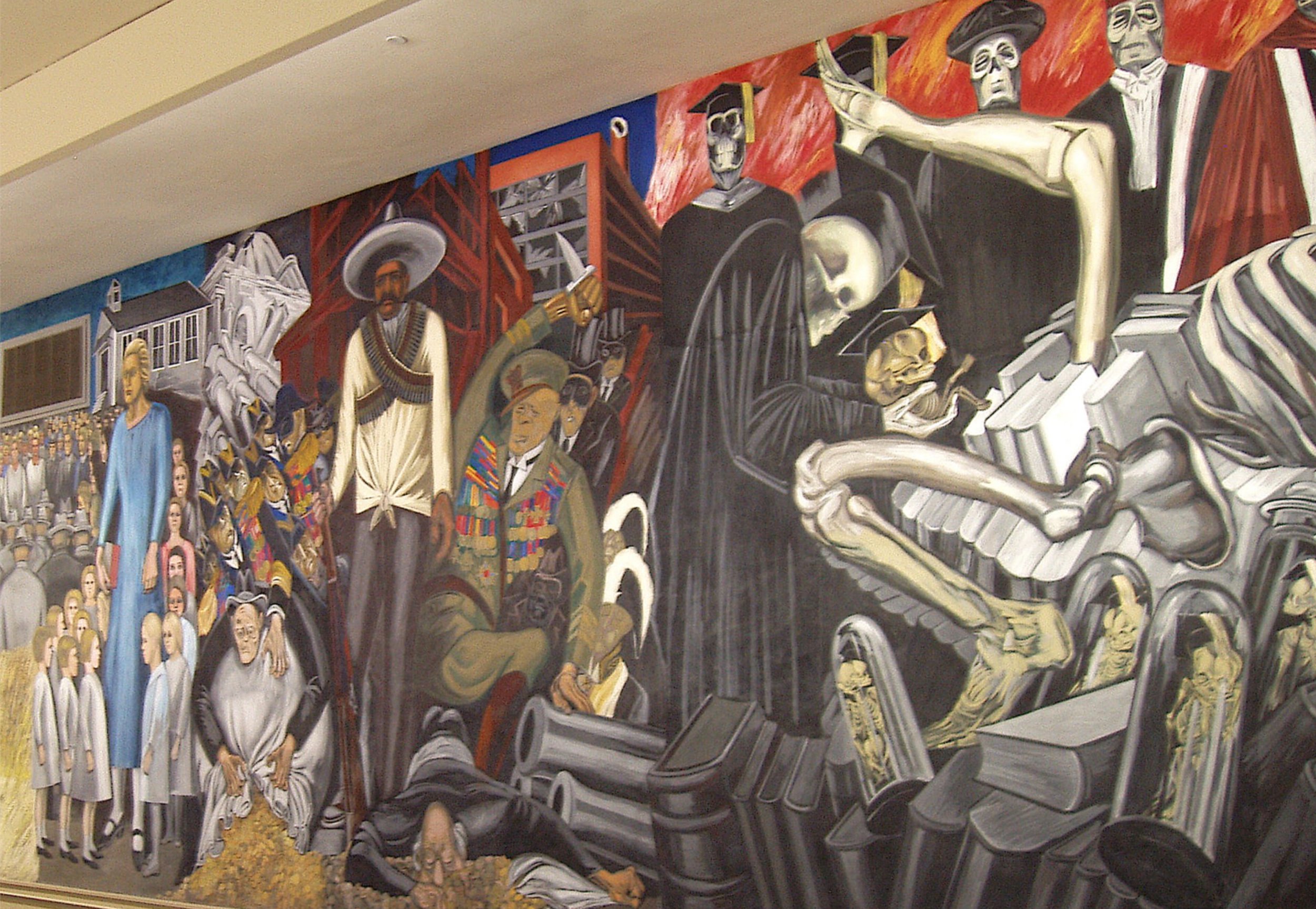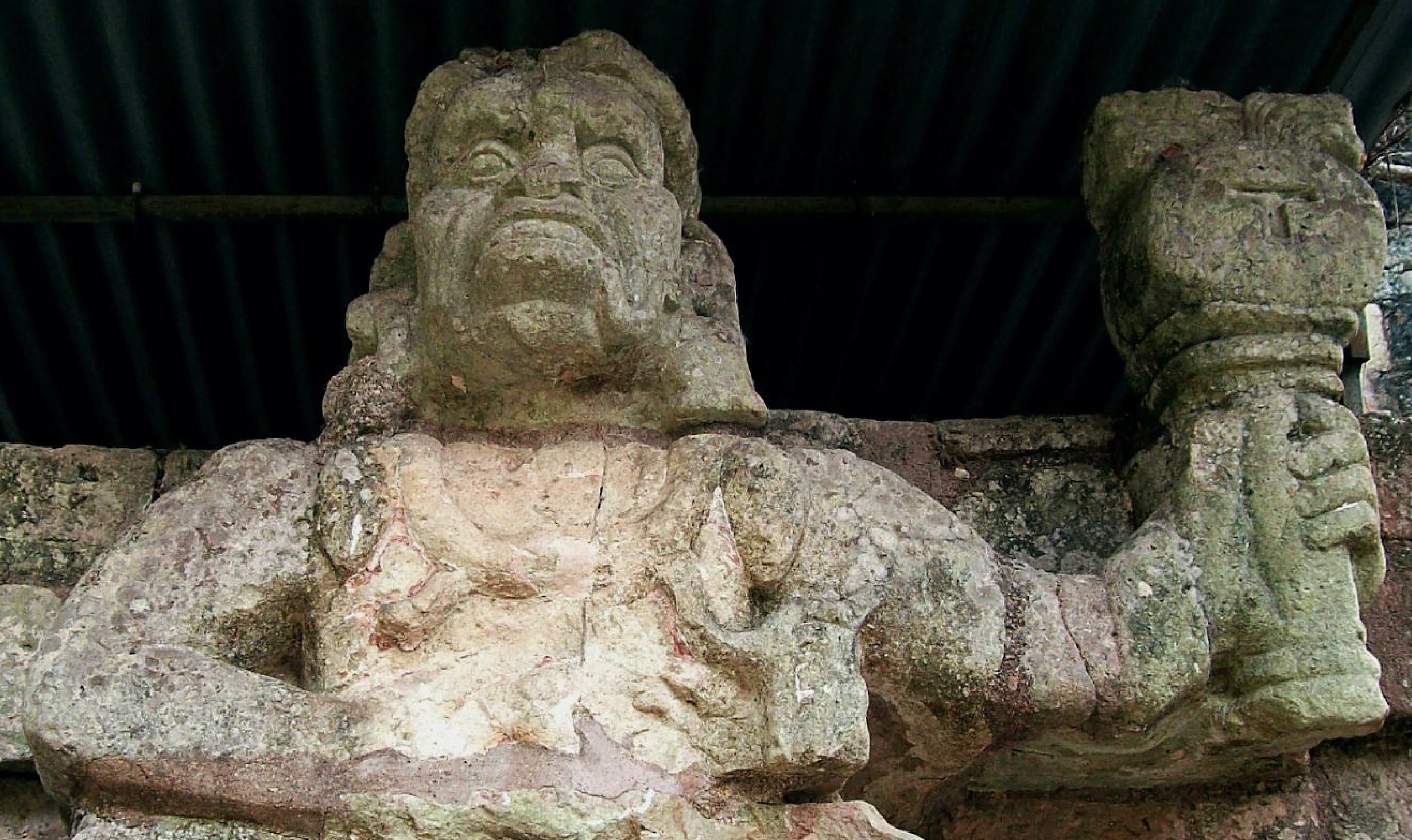Gospel & Universe ⛱ Señor Locke
Señor Locke & the Jaguar
☕️ 2000 🐾
As I sit here scribbling madly in the back pages of Fuentes’ novel, I assume the waitress is sitting at her table in the sun. I assume that she’s still staring at the salt shaker, turning it over with her slim fingers, the ones with the dark pink fingernails. That was the latest information I received from my sense impressions. But all of a sudden she’s standing above me, asking “Hola, ¿Que escribes?”
I'm too embarrassed to tell her that I'm writing about sense impressions and the meaning of Time. I'm even more embarrassed to say that I'm thinking about writing an epic poem on the history of Mexico. What do I know about Mexico? So I tell her I'm writing a love story. “Es un cuento de amor.”
“En serio? But I doubt what you say. Are you treating love or sex? It is always of essex about these men. Essex essex essex. ¿No es verdad?”
“I can’t argue with that.”
Her head tilts and her jade ear-rings fly into the jungle of her thick black hair as she asks, “¿Que?”
“Tienes razón. You're right. But to get to love, men need sex. And to get to sex, women need love.”
“Tienes razón.”
🐾
1519
My grand tale has taken a turn from the epic. Somewhere, sometime in my journey backward in time — in 1690 I suspect, the year Locke published his Essay — I swapped the chariot of Helios for the clacking wheels of battered wagons. Infinite perfect sunbeams for iron spokes, 18 muskets, and 15 horses, all clanking along a jungle trail in 1519. The imagined world for the real world. The epic for history.
I’ve swapped Odysseus, with his oars dripping salt tears in the Aegean, for the carcasses of burnt ships smoking on the sands of Vera Cruz. For it was on the Caribbean coast of the New World that Cortés forced his men to burn up all thought of retreat. At Vera Cruz, the True Cross.
I’ve also swapped the Gorgon and the Medusa for the jaguar, lord of the Americas. With spots like a cheetah, or black fur dark as a raven’s wing. And hypnotic green eyes.
Back in 1519 there was no Ithica, no Helen, no Penelope. There was no empirical gringo and no waitress with a silver cross hanging gently on her collarbone. The only woman of note was Malinche, the Native woman who served Cortés as interpreter, lover, and mother of his child. Malinche was then pawned off to one of his men, after bearing the first mestizo in history.
To serve and betray. To serve and be betrayed. To become a heroine and a curse. To become, at last, la chingada, the screwed one.
🐾
Shorn of epic mantle, of Homer’s dusty fingers pointing toward the rosy dawn, I follow the dirty trail of Cortés, and that lout Pizarro. I follow the old path of glory and riches, west to the Aztecs, south to the Incas, leaving Saint Francis behind, leaving Christ himself in the dust, until out of this infernal land-grab comes Bartolomé de las Casas to argue the case of the Indians. Backed by the Jesuits Xavier and Loyola, he becomes the conscience of the Western world. A dogmatic, stubborn conscience, yet a conscience nonetheless. The cross hanging on his neck trails blood from Nuevo León to Madrid.
🐾
🐾 In this epic there’s no Diana, no Beatrice, and no Venus standing like a Botticelli angel on a clam shell floating across the Aegean. There’s only a waitress and Malinche, only a damn gringo and a pinche conquistador, with his canons and his lust for a different kind of booty.
Cortes’ cortège, poco cortés, plunges uninvited into the mountains, where the Indians don’t use wheels, except as calendars, and they haven’t heard of gunpowder.
And the jaguar is a god.
And so:
Deep in the shady sadness of a vale
Far sunken from the healthy breath of morn,
Far from the fiery noon, and eve’s one star,
Sat the Olmec jaguar, quiet as a stone,
Still as the silence in his jungle of jade […]
☕️
The waitress was curt with me several hours ago when I asked for a menu. But over the course of the afternoon her mood shifted, and we even had a short conversation. The ice melted from her eyes, and in its place she started to smile, first at the things I said and at the way I said them. Then, after she attempted a few sentences in English, she quickly warmed up, perhaps realizing that we were in the same boat. She was studying English at the university, and wanted to go to art school.
When I started the novel, I’d read a paragraph or two, and carefully compare the Spanish on the left side of the page to the English on the right. I’d order another coffee, study a bit more, pay my bill, and stroll around town. But this is educational language program is becoming difficult. Fuentes has got me in his grip, and I’ve stopped looking at the Spanish side. I look up quickly to locate where my body is — somewhere in Mexico — and then dive back into the book.
Fuentes is writing about Mexico today and about the Mexico of the old lady, Consuela, who fell in love with a general at the time of the Second French Intervention, back in the 1860s. Fuentes is taking us back into national history and also back into the personal history of Consuela, who projects her mental state into the mind of the 15-year-old Aura. The general’s lust becomes the lust of Felipe, the protagonist. Consuela’s lust becomes the lust of Aura. Is this a comment on the way history can only be understood through personal experience? However distorted personal history may be, is it still more insightful than dates of battles, than the colonial visions of the monarchist Maximiliano de Habsburgo and his retrogressive Segundo Imperio Mexicano?
We can understand this European interference abstractly in terms of dates and famous figures, but when we think of it in terms of an old lady forcing her ancient lust on a 15-year-old it seems indecent rather than classical, destructive rather than conservative. The further, implied point about historical understanding — in which the lived is more powerful than the abstract — makes me flip to the back of the book, to the few blank pages into which I’m trying to squeeze my ideas about time, the waitress, jaguars, and the fate of Mexico. Half-jokingly, I give my epic prose poem the working mock-epic title, The Apocalyptic History of Mexico, from Hernán Córtes to Vicente Fox.
For a shadow has been cast over these pages, as if Huitzilopochtli the sun god was offended at my hubris: a Gringo Cortez, with dreams of conquest and doom!
I look up and see the waitress is standing there again, like Aura, with pupils like ink wells. But her right eye is greener than the eyes of a jaguar!
Her dark hair drifts like music across her face. When she flips her hair away from her eyes I feel the flick of a long black tale. Her svelte body slides in and out of the dark mouth of the café.
🐾 Out from the invisible depths of time comes the jaguar, across the jungles of Tabasco and into the flatlands of the Yucatán. He climbs to the peak of the Pyramid of the Jaguar in Tikal, the great stone edifice that rises from the green labyrinth of the jungle.
From there he peers north across the Yucatán, to the Platform of the Jaguars and Eagles at Chichen Itza, and then south to the complex of Copán, nodding a nod of recognition.
While men don’t know him, they worship his spirit, animating the wild, bringing all other predators to their knees. But most of all they fear him, prowler in the jungle, archetype for a world they can’t control.
Señor Jaguar looks west across the valleys and the far volcanoes to the greatest temple of them all: the Temple of the Sun in Teotihuacán, only ten miles north of Mexico City yet myth-worlds away and still a mystery: built in the time of the Romans. Why it fell and what it means is unclear. Especially to Señor J.
☕️ Inside Fuentes’ novel I become lost to the present tense. Locke’s sense impressions are firing deep inside the compressed, memorized impressions in my brain. These firings are wrapped in millions of layers of convolutions, as outlined in the neurological models of the Portuguese neurologist Antonio Damasio.
The internal firings are so intense that I don’t even take stock of the immediate sense impressions of me holding a book and reaching for my coffee. My brain does it unconsciously, but my body knows exactly what it’s doing.
I don’t even take stock of the fact that I’m at a café called la Oreja de Van Gogh, in the city of Guanajuato, somewhere in the middle of Mexico. Yet the waitress acknowledges this fact, and John Locke nods in recognition.
She asks me if I want a cappuccino and I barely nod, mesmerized by my love affair with words. I only subconsciously take in the rich colours of the square around me, and the scent of her perfume.
Yet everything connected to my distorted, inner world seems real, as tangible as if I myself were wandering in the old lady’s labyrinth, translating the old French documents, and wondering who is that phantasmal girl, Consuela’s aura, only capable of speaking when the old lady speaks?
The coffee stains on the morning paper take on a macabre significance. The blue book blurs into the squares of the blue table.
🐾 The prehistoric feline stalks me everywhere, from the black cat crouched on my table to my memories of the stone and fresco faces in the ancient temples and the murals of Tlaxcala. And then there’s the Señor Jaguar of the markets, a trinket for the tourists who ends up with a monstrous fanged momento about to pounce on them from their living room wall…
I try to imagine what the jaguar thinks of these strange men who create their images and read their books. What to make of their armies and their gold, their cries of Empire, their preserved bodies in tombs and fluids, their books lined up like organs on an operating table? What to make of the the flags and statues that are really chains around their ankles, and of the books that are really sterile and moribund attempts to create life that already exists?
What to make of the fact that’s it's all overseen by educated skulls in hats, by generals with daggers — or by the simple soldier with his double belt of bullets criss-crossing his heart?
I’m sure the jaguar resents being part of this artistic historical charade, this negation of direct experience in favour of carved statures and colourful murals. And it doesn’t even make any sense: one moment he’s depicted as beaded knick-knack for tourists, and the next he’s a symbol of mysterious danger from Mexico to Argentina.
Now he has to put up with being used again, by a gringo no less, and made into yet another symbol by a Canadian tourist with a Don Quixote complex, the pen in his fingers pointing at windmills that turn in Van Gogh’s churning sky. A Canadian tourist with a penchant for Locke and the dagger of Montezuma stuck in his brain.
Señor Jaguar remembers the stone image at Copán. The Howling Monkey God. They’re all the same.
Señor Jaguar never felt heroic, never was a symbol, let alone the god, these humans made him out to be. It’s all just a crazy concoction of the humans, those animals who have forgotten that the world lies at the tips of the fingers, at the junction between retina and instinct, not in the looped and bragging circuits of the brain.
The whole business is so pathetic he would smirk or smile, if only he could, as he watches each savage tribe trip by, through the jungles and across the plains of history. They trip, slip, and crack their skulls so awkwardly along their path that it seems they aren’t even feeling the earth beneath them. It’s as if they haven’t even studied the writings of John Locke and are entirely unaware of where they are. As if they’re looped into the internal dreams of El Dorado, with figures of Crosses and Conquest, and therefore forget where they are, forever turning the world over in their minds.
🐾
And thus does Señor Locke colour my world, so that I begin to see it the way Newton saw it in the 1660s, when he proved that the colours we see are only a function of our perception: his colour wheel had distinct colours on it, yet when he spun it the wheel appeared to be white.
This experiment in optics may seem out of place in the annals of Monsieur Jaguar, yet it coincides with Locke’s model of the mind, according to which we colour the world the way we see it, not the way it is. This suggests that other modes of perception — those of a jaguar for instance — are just as true or realistic as our own.
☕️ The waitress told me that she wants to study the murals all over Mexico, but that she wants to paint them differently. And not always with the same Mexican themes. She’s tired of conquistadors and crosses and angry Indians. In any case, it’s been done to death by Orozco and Diego and the band of brilliant old-timers.
She likes this café because they’ve painted something different, something that takes her away from the eternal dichotomy between the good Benito Juarez and the nightmares of the narcotraficantes and all the two hundred years of violent circular solitudes that have kept Mexico down. She doesn’t see why she can’t combine the style of the Mexicans and the Dutch masters — Pacheco and Bosch, Rivera and Rubens, Siqueiros and Van Gogh.
🐾 The world is in front of us but we spin it into the past or the future, depending on the direction of the impressions that the senses have made in our minds. And yet, as Proust so elegantly illustrates, these impressions are themselves memories, patched together from the chance impressions of our lives.
Yet none of this impresses Monsieur Jaguar, who doesn’t have time for the theories of the feedback memory loop machines called humans. They’re always thinking about the future and what they think they’re going to find, or about the past and what they’ve lost — some garden called Eden where a woman made a man eat a madeleine and drink a cup of Earl Grey. Monsieur Jaguar can’t quite remember the plot. Nor can he figure out where the Garden is.
Humans are always making images of themselves, and imagining these images are who they are. They’re simply incapable of living in the present, thinks M. Jaguar.
🐾
Nor does Señor Jaguar much care for the ballads these scrawny Spaniards sing. Their leather-bound poems leave him completely indifferent. O Beatrice! O, Rocinante, mi amor, estoy aquí, je t’adore, Jean-Jacques, donne-moi des plumes, je n’aime plus les madeleines, sono io il poeta. What’s all that Latin nonsense about?
Señor J. has no appetite for poems, except the ones about the Cyclops and the Maenad, those ancient man-eaters whose rites are quite intriguing. All that flesh-eating makes him want to pounce, if only he could get off his stone pedestal, with its two hundred and sixty day Mayan calendar and its pantheon of blood-thirsty gods blocking his way!
The blood-thirsty part of human mythology Sr. Jaguar gets (he could use a sangria martini himself), but it’s the sacrifice part that completely escapes him. Why rip the heart out if you’re not going to eat it? Why raise it to the sky? And why bother to chop the head off and send it bouncing down a stair?
The humans have made quite the little worlds for themselves, inside those oversized heads of theirs.
But one could not accuse Señor Jaguar of being a complete Philistine: he does have a grudging respect for Ovid and all those miraculous transformations: owls becoming trees, men becoming wolves. It makes a strange sort of sense, although he can’t figure out how or why. The idea that intrigues him most is from Heraclitus: something about a river and stepping in it twice. Perplexed, he steps back across the river and slinks into his green jungle of time.
How do I understand that animal, John Locke?













